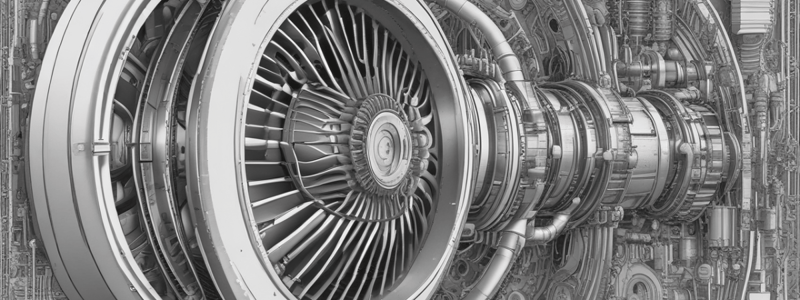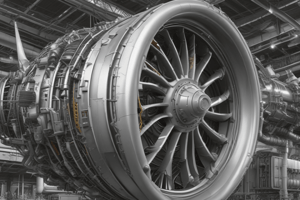Podcast
Questions and Answers
What is the primary function of the diffuser in a gas turbine engine?
What is the primary function of the diffuser in a gas turbine engine?
- To convert velocity energy into pressure energy (correct)
- To increase the velocity of the air
- To deliver air to the combustion chambers
- To change the airflow direction
What is the purpose of the turning vanes or cascade vanes in the manifold?
What is the purpose of the turning vanes or cascade vanes in the manifold?
- To distribute air to the combustion chambers
- To increase the airflow velocity
- To reduce air pressure losses (correct)
- To change the airflow direction
What is the function of the compressor outlet elbow?
What is the function of the compressor outlet elbow?
- To change the airflow direction
- To act as an air duct (correct)
- To distribute air to the combustion chambers
- To increase the air pressure
What is another term for a single-entry impeller?
What is another term for a single-entry impeller?
What is the purpose of the manifold in a gas turbine engine?
What is the purpose of the manifold in a gas turbine engine?
What is a disadvantage of the single-stage dual-sided impeller?
What is a disadvantage of the single-stage dual-sided impeller?
What material is the diffuser typically made of?
What material is the diffuser typically made of?
What is the function of the outlet ducts in the compressor manifold?
What is the function of the outlet ducts in the compressor manifold?
What is the purpose of inlet guide vanes?
What is the purpose of inlet guide vanes?
What replaces the single-stage dual-sided impeller?
What replaces the single-stage dual-sided impeller?
What is the purpose of stationary pre-swirl vanes?
What is the purpose of stationary pre-swirl vanes?
Where are inlet guide vanes sometimes formed?
Where are inlet guide vanes sometimes formed?
What is the direction of airflow and compression in an axial compressor?
What is the direction of airflow and compression in an axial compressor?
What is a common drawback of single-spool compressors?
What is a common drawback of single-spool compressors?
What is the main difference between a single-spool and a dual-spool engine?
What is the main difference between a single-spool and a dual-spool engine?
What type of axial flow compressor is typically used in small turboshaft and turboprop engines?
What type of axial flow compressor is typically used in small turboshaft and turboprop engines?
What is a characteristic of a triple-spool engine?
What is a characteristic of a triple-spool engine?
What is an advantage of dual-spool engines over single-spool engines?
What is an advantage of dual-spool engines over single-spool engines?
What happens to the kinetic energy of the air as it passes through the stator vanes?
What happens to the kinetic energy of the air as it passes through the stator vanes?
What determines the velocity of the airflow in each stage of the compressor?
What determines the velocity of the airflow in each stage of the compressor?
What is the secondary function of the stator vanes?
What is the secondary function of the stator vanes?
What are the blades typically made of?
What are the blades typically made of?
What is a blisk?
What is a blisk?
What is the material used to make the discs?
What is the material used to make the discs?
What is the operating zone between the ‘normal operating line’ and the ‘surge stall line’?
What is the operating zone between the ‘normal operating line’ and the ‘surge stall line’?
At what point does the engine operate during most of its service life?
At what point does the engine operate during most of its service life?
What may occur when a stall or surge causes a momentary stagnation of mass airflow followed by an over-rich condition in the combustor?
What may occur when a stall or surge causes a momentary stagnation of mass airflow followed by an over-rich condition in the combustor?
What is the purpose of the compressor anti-stall bleed system?
What is the purpose of the compressor anti-stall bleed system?
Why is the compressor anti-stall bleed system necessary?
Why is the compressor anti-stall bleed system necessary?
What is dumped directly back into the atmosphere by the compressor surge/stall bleed air valve system?
What is dumped directly back into the atmosphere by the compressor surge/stall bleed air valve system?
Flashcards are hidden until you start studying
Study Notes
Impellers
- Impellers can be referred to as single-entry (single-sided) or dual- or double- entry (dual-sided)
- Single-stage dual-sided impeller provides the same compressor ratio and mass air flow with a smaller impeller diameter
- Single-entry two-stage centrifugal turbo-propeller replaced the single-stage dual-sided impeller due to its disadvantages
Impeller Components
- Impellers incorporate inlet guide vanes called rotating guide vanes or inducers
- Inlet guide vanes induce rotation of the air into the eye of the impeller
- Inlet guide vanes may be part of, or attached to, the impeller
- Inlet guide vanes can be formed by inclining the front sections of the impeller vanes to impart a whirl motion in the direction of impeller rotation
Diffuser
- High-velocity air from the impeller is slung into divergent ducts within the diffuser
- The purpose of the diffuser is to convert velocity energy into pressure energy
- Diffusers are typically made from aluminum alloy or steel alloy
Manifold
- The purpose of the manifold is to change the airflow direction and deliver air to the combustion chambers
- Turning vanes, or cascade vanes, within the manifold straighten the airflow
- Manifold distributes the air in a smooth flow to the combustion section
Axial Flow Compressors
- Axial flow compressors have airflow and compression occurring parallel to the rotational axis
- There are three types of axial flow compressors: single-spool, dual-spool, and triple-spool
- Single-spool axial flow compressors are commonly used in small turboshaft and turboprop engines
Rotor Blades
- Each rotor consists of a set of blades fitted into a disc, which move air rearwards through each stage
- The speed of the rotor determines the velocity present in each stage
- Kinetic energy is transferred to the air with increased velocity
- Stator vanes receive the air at high velocity and act as a diffuser, changing kinetic energy to potential energy (pressure)
Blisks
- Blisks are one-piece blade and rotor units
- Blisks are commonly used in small turboprop and turboshaft engines
- Blisks are being applied to many smaller fans, compressor rotors, and stators, and to some turbine components
Surge-Stall Margin
- The surge-stall margin is the operating zone between the 'normal operating line' and the 'surge stall line'
- The margin decreases as compressor efficiency deteriorates
- Design point is the point on this line at which the engine operates during most of its service life
Studying That Suits You
Use AI to generate personalized quizzes and flashcards to suit your learning preferences.




